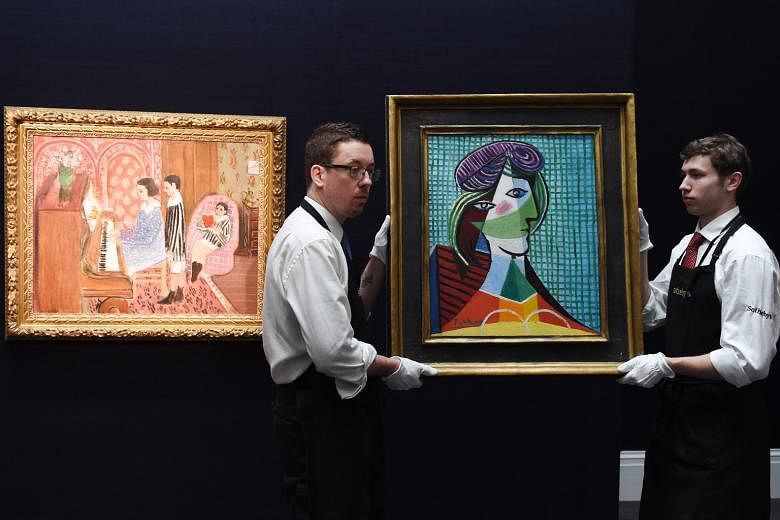LONDON • So now it is official: The art market boom has peaked, according to figures from Christie's and Sotheby's, the biggest international auction houses.
Late last month, the companies released their 2015 results, with each reporting a slight decrease in year-over-year sales. It was the first year since 2010 that both failed to show an increase.
Christie's, a private company based in London, reported auctions and private sales of £4.8 billion (S$9.8 billion) last year, a decline in pounds of about 5 per cent from 2014. Equivalent sales at Sotheby's, which is publicly traded and based in New York, were US$6.6 billion (S$9.4 billion), about 1 per cent less than in 2014.
Those figures do not represent a burst bubble, but they suggest that this year is going to be challenging for the art market, reflecting the volatility of the wider world.
"The froth has been skimmed off," said Mr Paul Ress, chief executive of Right Capital, which provides loans secured by art to dealers and collectors. He said the collapse in the price of oil had taken "a huge amount of cash" out of the art market.
"There aren't so many Russians and Brazilians involved now and the Chinese slowdown has had a knock-on effect on the raw materials and equity markets. The potential buyers in the art world won't be feeling as rich as they did last year."
Christie's results reveal key shifts in the market last year.
Bolstered by huge prices in New York for trophy works by artists such as Picasso and Modigliani, auction sales of Impressionist and modern art were up 57 per cent from 2014 to £1.3 billion, while auction sales of post-war and contemporary art - the main driver of growth from 2009 to 2014 - were down 14 per cent to £1.5 billion. Year-over-year sales of old master paintings, 19th-century and Russian art shrank 37 per cent to £154.9 million.
"It's a healthy correction," said Mr Roman Kraussl, an associate professor of finance at the University of Luxembourg and co-author of Is There A Bubble In The Art Market?, a research paper that tracked prices from 1970 through 2013, published last month in the Journal Of Empirical Finance.
Owners, wary of a downturn, have become more reluctant to sell high-value works. Sotheby's and Christie's February auctions in London of Impressionist and modern, as well as contemporary, art are smaller and carry lower estimates than their equivalent events last year.
Sotheby's evening sale tomorrow of Impressionist and modern art contains 54 works, compared with 75 last February. That auction grossed £186.4 million.
This week, it is expected to raise at least £97.6 million.
The evening's star lot is Tete De Femme, a 1935 Picasso study of his lover and muse Marie-Therese Walter.
It has a low estimate of £16 million. Its current owner bought it at Sotheby's in New York in November 2013 for US$39.9 million.
On Feb 11, at Christie's evening contemporary sale, the auction house and a third-party financier are banking that the market for the Scottish painter Peter Doig is bubble-proof.
Doig's 1991 canvas, The Architect's Home In The Ravine, is guaranteed to sell against a low estimate of £10 million, £2.3 million more than it brought at auction in London three years ago.
Overall expectations have also contracted at Christie's. The 62 lots of its evening contemporary sale have a total minimum valuation of £50.4 million, almost half the low estimate the company placed on its equivalent 64-lot auction last year, which took in £117.1 million.
With investment-conscious buyers nervous about spending significant sums on works by artists without established reputations, the new category of "20th-century art", to which the Picasso and the Doig both belong, now dominates the market.
Sotheby's and Christie's both used the label "20th century" to promote their February sales. And Phillips, whose contemporary auctions used to be synonymous with the hottest emerging names, is holding its inaugural sale of 20th Century And Contemporary Art in London on Feb 9. Adding big names from the last century, such as Willem de Kooning and Giorgio de Chirico to Mark Bradford and Tauba Auerbach, helped Phillips realise US$523 million in auction sales last year, a 34 per cent increase over 2014.
But is the market for 20th- century art a bubble about to burst, just as the market for Impressionist art imploded in 1991?
Mr Kraussl does not think so, at least at the very top of the market.
"Art is now a must-have for the rich," he said. "Every collection has to have a Picasso, a Richter, a Warhol."
NEW YORK TIMES

